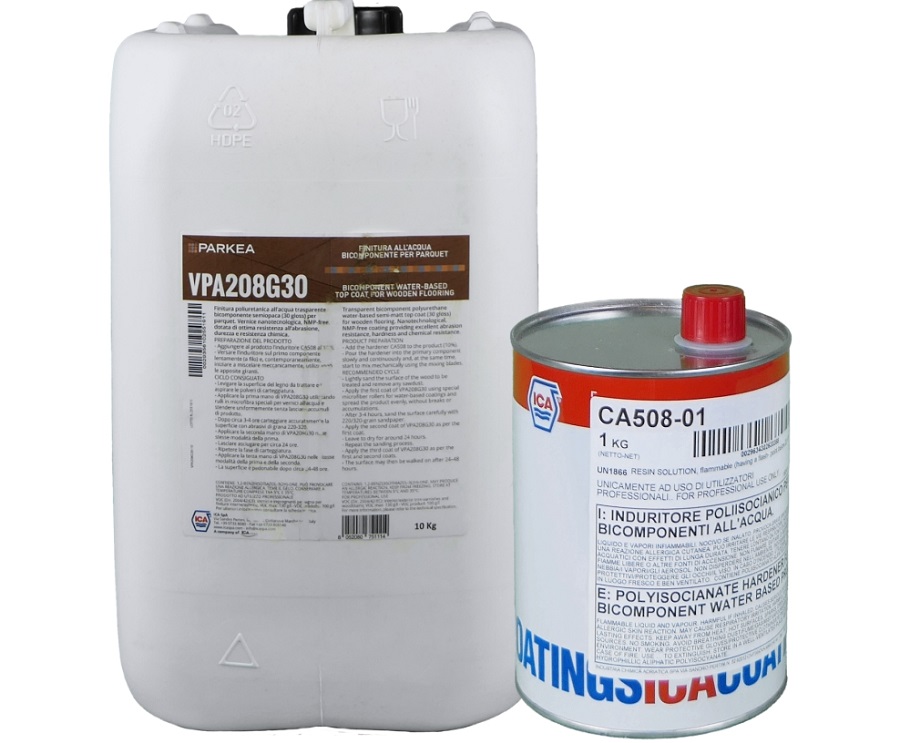Wooden floors are usually varnished after installation. It is rare for floors to be ready lacquered and refin refinishing will still be carried out after years of use anyway. The classic solvent-based varnish is resistant, but has the disadvantage of long-lasting odors. This can be avoided by using water-based floor varnish. It is hard-wearing, durable, easy to apply and has a pleasant appearance. Lake VPA208 (can be bought online from Market.Market) from Italian manufacturer ICA's PARKEA range is one such product.
Why water-based varnish for floors
- No overpowering solvent odor. The water-based alternative is good for both the craftsman who applies it and the recipient. The smell of a solvent-based varnish can linger indoors for weeks if the premises do not have effective ventilation, and this can be a big problem.
- Flammability risk totally eliminated. Any product containing solvents means a risk of flammability and special requirements in terms of application and residue disposal management. Using water-based floor varnish eliminates these problems.
- Water-based varnish yellows wood much less than solvent-based varnish. On application, the surface takes on the wet look of lacquered wood, but does not turn yellow as with solvent-based varnishes.
- Materials and tools used for application are washed with water. If washed immediately after use, the varnish is easily removed with water. It also eliminates odor and the extra cost of cleaning materials.
- The above benefits are achieved without compromising on quality. The resulting surfaces are hard, abrasion and impact resistant, have high chemical resistance and are durable. PARKEA VPA208 is resistant to heavy traffic, even car wheels, without tire marks remaining on the varnished surface.
PARKEA VPA208 varnish features
Aspect. Although transparent, the lacquer in the can is whitish. This is a characteristic of water soluble products, the water in the composition creating this opalescence. Once the water evaporates, the varnish becomes clear. It is therefore not recommended to apply thick coats, as surface drying may prevent the water from completely draining off. Recommended application coverage is 60-90 g/m²/coat.
Catalyzing. The varnish is A+B, the catalyst is 10%. The catalyst CA508, recommended for the VPA208 lacquer, is non-yellowing so that the floor retains its original appearance over time. When mixing, the catalyst is added in thin threads, under continuous stirring, not all at once, to avoid hardening on contact with the water in the lake.
Dilution. The resulting mixture is ready for use. It may be diluted with water if necessary, but not more than 5%. Water is added after the varnish is thoroughly mixed with the hardener, not before. The catalyst is sensitive to water and hardens in direct contact with it. The mixture has a pot-life of 4 hours.
The varnish can be used to protect heavily trafficked surfaces and is highly resistant to abrasion, scratching and impact. It has very good resistance to chemicals and light. It is available with 3 degrees of gloss different: 10 - deep matt, 30 - semi-matt, 60 - semi-glossy.
The gloss grade is indicated in the product code after the gloss letter G (e.g. VPA208G30 has gloss 30).
Being a water-based product it must be protected from frost and cannot be applied at temperatures below 10°C.

How to apply to get tough, smooth surfaces
For application you need a squeegee with microfiber roller or brush. It is easier with the squeegee because the varnish spreads better and more evenly. Before finishing, the parquet must be properly sanded and de-sanded. The old flooring is scraped to remove the old varnish and wood blackened by water and dirt and is chituiește where appropriate.
The varnish mixture obtained as recommended above can be applied immediately. Avoid adding extra water because the wood will absorb it and the grain will rise, making it difficult to sanding between layers. The prepared varnish can be used for 4 hours, so the recommendation is to prepare as much as you are sure you can use in that time. After 4 hours the varnish starts to thicken in the container and can no longer be used. Adding water doesn't help, as the chemical reaction between the 2 components is already in progress.
It is recommended to apply 3 coats with a consumption/coat between 60 and 90 g/m². The first coat can be sanded 3-4 hours after application. Sand with sandpaper 240-320, depending on the gloss of the varnish, finer paper being used for glossier varnishes. It must be sanded after the first coat because the water lifts the wood grain and sanding smoothes the surface again. After sanding and dusting, apply the second coat. If the parquet surface is sufficiently smooth and pleasant to the touch, the third coat can be applied, without sanding, at least 2 hours after the second coat and a maximum of 8 hours. After 8 hours, the surface must be sanded before applying a second coat, otherwise the varnish layers will not adhere to each other. The second coat is best sanded 12-16 hours after application.
The floor can be walked on at least 24 hours after the application of the last coat, if the indoor temperature is above 23°C and the relative air humidity approx. 60%. At increased humidity in the atmosphere and reduced air circulation in the room, the time may increase up to 48 hours. The surface is considered completely dry 5-7 days after application and maximum strength is reached after 2-3 weeks.
What to remember to get the result you want
The advantages of using water-based floor varnish are, I think, obvious. When used according to the recommended technology, it will make the protected surfaces tough and durable, whether it's parquet flooring, stairs, floorboards or a tabletop. And for the result to be as expected, I come back to the points to remember:
- Sand the flooring properly before application. Repair any defects in the wood before applying the varnish.
- Mix the catalyst by pouring it in a thin trickle under stirring.
- Add water only if needed and no more than 5%.
- Always sand after the first coat. The most beautiful surfaces are achieved by sanding after each coat.
- After 8 hours between applications, sanding is mandatory. Water-based varnishes are more special, they do not "break" like solvent-based varnishes, they are more elastic and the molecules are better bonded together. If the layers are not well bonded to each other (impossible without sanding after a certain time), adhesion is poor and they can easily come off easily when shocked. In this case the varnish layer takes like a skin, all over the surface. It can even be vacuumed if the vacuum cleaner is a powerful one.
- If the varnish is semi-glossy, use at least 320 grit sandpaper for sanding between coats. The gloss emphasizes any flaws, and very fine scratches made on the surface by the coarser paper will become visible.
- Do not allow more than 7 days between applications. The coating hardens very hard, becomes tough and resistant to scratching and therefore sanding. Sanding will be heavy and therefore poorly done and adhesion will suffer.
- Relative humidity and air currents are very important for drying a water-based pond, even more important than temperature. If the humidity is very high and the air is not circulating, the drying time increases, perhaps even doubling.
I hope you find the above information useful. If you have any clarifications or questions, leave them below in the dedicated space. I will certainly reply.
VPA208 varnish can be purchased on Market.Market.





































Add comment